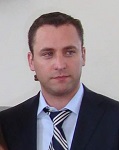Numerical study of mass and heat transport within a ceramic porous tank
Abstract
In porous media, the thermal transfer phenomenon is widely applied in diverse energy-intensive industrial processes. This research paper aims to elucidate the simultaneous transfer of mass and heat within a ceramic porous tank. To simulate these transport phenomena, a numerical method is developed: Control Volume Finite Element Method (CVFEM), in conjunction with the utilization of a free mesh generator called Gmsh. The study showcases numerous simulation results that depict the transport phenomenon, such as the three-dimensional evolution of three parameters (temperature, saturation and pressure) during the heating of the ceramic tank. By employing this numerical model, a more comprehensive comprehension of these transport phenomena can be achieved.
Copyright (c) 2023 Ramzi Rzig, Minyar Mnakri, Nidhal Ben Khedher

This work is licensed under a Creative Commons Attribution-NonCommercial 4.0 International License.
References
Luikov AV. Systems of differential equations of heat and mass transfer in capillary porous bodies. International Journal of Heat and Mass Transfer 1975; 18(1): 1–14. doi: 10.1016/0017-9310(75)90002-2
Whitaker S. Simulation Heat, Mass and Momentum Transfer in Porous Media: A Theory of Drying. Academic Press; 1977.
Kabeel AE, Abdelgaied M. Numerical and experimental investigation of a novel configuration of indirect evaporative cooler with internal baffles. Energy Conversion and Management 2016; 126: 526–536. doi: 10.1016/j.enconman.2016.08.028
Hettiarachchi HDM, Golubovic M, Worek WM. The effect of longitudinal heat conduction in cross flow indirect evaporative air coolers. Applied Thermal Engineering 2007; 27(11–12): 1841–1848. doi: 10.1016/j.applthermaleng.2007.01.014
Fung LSK, Hiebert AD, Nghiem LX. Reservoir simulation with a control volume finite element method. SPE Reservoir Engineering 1992; 7(3): 349–357. doi: 10.2118/21224-PA
Abdelsalam SI, Alsharif AM, Abd Elmaboud Y, Abdellateef AI. Assorted kerosene-based nanofluid across a dual-zone vertical annulus with electroosmosis. Heliyon 2023; 9(5): e15916. doi: 10.1016/j.heliyon.2023.e15916
Li J, Rajajayavel SRC, Ghoshal S. Transport of carboxymethyl cellulose-coated zerovalent iron nanoparticles in a sand tank: Effects of sand grain size, nanoparticle concentration and injection velocity. Chemosphere 2016; 150: 8–16. doi: 10.1016/j.chemosphere.2015.12.075
Kiwan S, Soud QR. Experimental investigation of the thermal performance of a sand-basalt heat storage system for beam-down solar concentrators. Case Studies in Thermal Engineering 2020; 19: 100609. doi: 10.1016/j.csite.2020.100609
Cao Y, Ayed H, Algelany AM, et al. Receiving heat from a PCM tank by using natural convection of water and NEPCM: A simulation for LHTES application. Case Studies in Thermal Engineering 2022; 35: 102123. doi: 10.1016/j.csite.2022.102123
Al-Yaqoubi S, Al-Maktoumi A, Kacimov A, et al. Fresh-saline water dynamics in coastal aquifers: Sand tank experiments with MAR-wells injecting at intermittent regimes. Journal of Hydrology 2021; 601: 126826. doi: 10.1016/j.jhydrol.2021.126826
Thien FY, Hamasaki K, Shapawi R, et al. Effect of background tank color in combination with sand substrate and shelters on survival and growth of Scylla tranquebarica instar. The Egyptian Journal of Aquatic Research 2022; 48(3): 241–246. doi: 10.1016/j.ejar.2022.04.004
Zuo Y, Zhang M, Cheng F, Zhou H. Experimental investigation of the migration and solidification characteristics of Solar Salt in hot sand layer of tank foundation. Applied Thermal Engineering 2023; 219, Part B: 119571. doi: 10.1016/j.applthermaleng.2022.119571
Lee JH, Lee SH, Han SW. Nonlinear earthquake responses of unanchored cylindrical liquid storage tanks on flexible soil. Structures 2023; 54: 1465–1490. doi: 10.1016/j.istruc.2023.05.070
Moreno M, Colombo J, Wilches J, et al. Buckling of steel tanks under earthquake loading: Code provisions vs FEM comparison. Journal of Constructional Steel Research 2023; 209: 108042. doi: 10.1016/j.jcsr.2023.108042
Abdellatif HE, Belaadi A, Alshahrani H, et al. Modeling three-dimensional flow in a thermal energy tank: Numerical analysis of the impact of tank shape on the melting and solidification of phase change material. Journal of Energy Storage 2023; 72, Part A: 108286. doi: 10.1016/j.est.2023.108286
Dittus FW, Boelter LMK. Heat transfer in automobile radiators of the tubular type. International Communications in Heat and Mass Transfer 1985; 12(1): 3–22. doi: 10.1016/0735-1933(85)90003-X
Balliga BR, Patankar SV. A new finite-element formulation for convection-diffusion problems. Numer Heat Transfer 2007; 3: 393–409. doi: 10.1080/01495728008961767
Balliga BR, Patankar SV. A contro volume finite-element method for two-dimensional fluid flow and heat transfer. Numerical Heat Transfer 2007; 6: 245–261. doi: 10.1080/01495728308963086
Geuzaine C, Remacle JF. Gmsh: A 3-D finite element mesh generator with built-in pre- and post-processing facilities. International Journal for Numerical Methods in Engineering 2009; 79 (11): 1309–1331. doi: 10.1002/nme.2579



